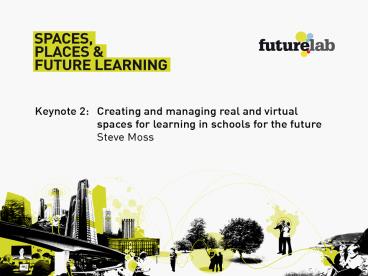Real and Virtual Learning Spaces - PowerPoint PPT Presentation
1 / 22
Title:
Real and Virtual Learning Spaces
Description:
Versatility - the property of space that allows for multiple uses ... Modifiability - the spatial property which invites active manipulation and appropriation ... – PowerPoint PPT presentation
Number of Views:78
Avg rating:3.0/5.0
Title: Real and Virtual Learning Spaces
1
(No Transcript)
2
One of the clinical definitions of insanity is
doing the same thing over and over again and
expecting to get a different result.
John Abbott
3
Building Schools for the Future
4
45,000,000,000
over 15 years of which
4,500,000,000 for ICT
5
Rebuild 50 Substantially remodel 35 Refurbish
15 of secondary schools in England and equip
them with new ICT equipment and shared learning
platforms
6
A 21st century environment for learning
- The BSF programme gives us a unique chance to
design and create new physical and virtual spaces
at the same time.
- Together, these constitute a 21st century
environment for learning.
7
Questions, questions
? - what sort of education do we want to see in
future?
? - what sorts of learning relationships do we
want to foster?
? - what competencies do we want learners to
develop?
? - What tools and resources are available to us
to support learning?
? - what buildings do we want?
? - how many classrooms do we need?
Re-Imagining Learning Spaces - Futurelab, 2006
8
Spaces are themselves agents for change. Changed
spaces will change practice. JISC, 2005
9
Spaces for Learning
These learning scenarios occur whether we arrange
the spaces or not. We can facilitate deeper and
richer learning when we design spaces with
learning in mind. Nancy Van Note Chism, 2006
10
Enhancing the Environment for Learning
- BSF creates new physical and virtual spaces.
- The two taken together constitute the environment
for learning - The physical space should be flexible and
enhanced by the use of ICT - The virtual space should be learner-centric and
match the highest quality Management Information
Systems with innovative content management and
creation facilities.
11
Defining flexibility
Torin Monahan (2002) defines flexibility in terms
of five properties of space Fluidity - the
design of space for flows of individuals, sight,
sound, and air Versatility - the property of
space that allows for multiple uses
Convertibility - ease of adapting educational
space for new uses Scalability - a property of
space for expansion or contraction Modifiability
- the spatial property which invites active
manipulation and appropriation
12
13
Form follows function
- What might schools look like if
- Multidisciplinary teams of professionals took
corporate responsibility for a cohort of students - Students werent grouped in uniformly sized
classes - Students werent expected to move from one 60m2
room to another almost identical one every hour - If study spaces were designed and furnished for
collaborative as well as individual work - Older students were not always required to be
physically present in order to be attending - If ICT infrastructure and portable devices were
ubiquitous?
14
- Informal learning spaces are those outside the
classrooms Malcolm Brown, Educating the Net
Generation - Informal learning spaces are those in which
students live and learn at their discretion. They
choose the time and the place to address the work
that flows from formal learning spaces and into
their lives as homework, projects, ideas to mull
over, and conversations to have. Alan Cattier,
2006 - If you get wireless reception under a tree,
there really isnt any need to be in a
classroom. W.M. Mitchell, 2003
15
- Given the chance, learners choose the locations
where they feel most empoweredand most
comfortableto complete the work at hand. - In places where they see the best support for
their way of working, they feel safe and so
return frequently, knowing they can move through
material and concepts on their terms. In places
where they feel discomfort, a lack of connection
to space and infrastructure, they leave or
disengage.
16
The Virtual Learning Space
- Should enable learners and teachers to find,
organise and create content and learning
resources in ways which are flexible and not
necessarily based on taxonomies or atomised
classifications. It has to be more than a content
delivery system. - Learners must feel that the experience is a
personal one. - The space should also recognise and facilitate
the social dimensions of learning encouraging
collaborative work.
17
Virtual Workspace
18
Virtual Workspace
19
Virtual Workspace
20
So what does research tell us?
- Virtual learning is a breakeven proposition
- Virtual learning provides flexibility to its
users - In general, researchers find that students in
distance-learning situations perform as well as
their counterparts in face-to-face, traditional
schooling. - Lemke, 2006
results are determined by learner control,
dialogue, learner support, and opportunities for
direct learner involvement
21
There are few financial or technological barriers
to achieving transformation through the Building
Schools for the Future programme. Almost all the
barriers are in our heads.
22
Thank yousteve.moss_at_p4s.org.uk
Thanks to Marcus Orlovsky _at_ Bryanston Square for
some great photographs of schools old and new































